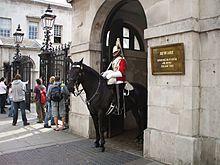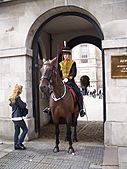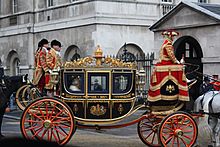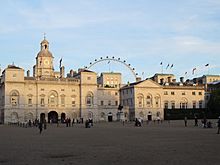Horse Guards (building) facts for kids
Quick facts for kids Horse Guards |
|
|---|---|
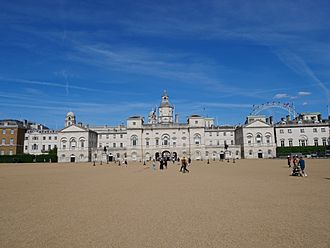
Horse Guards viewed across Horse Guards Parade with the London Eye Ferris wheel in the background.
|
|
| General information | |
| Type | Military headquarters, barracks and stables |
| Architectural style | Palladian |
| Location | London, SW1 |
| Construction started | 1750 |
| Completed | 1759 |
| Technical details | |
| Floor count | four |
| Design and construction | |
| Architect | William Kent, John Vardy and William Robinson |
Horse Guards is a very old and important building in London. It stands between Whitehall and Horse Guards Parade. This building was finished in the mid-1700s. It replaced an older building that was there before.
Horse Guards was built as a place for soldiers to live and keep their horses. These soldiers were part of the Household Cavalry. For many years, until 1858, it was the main army headquarters for the British Empire.
The building used to be the entrance to the Palace of Whitehall. Later, it became the entrance to St James's Palace. Because of this, it is still guarded every day by the King's Life Guard.
Today, Horse Guards is still used by the military. But part of it is now the Household Cavalry Museum. This museum is open to everyone. The building also acts as a special gateway between Whitehall and St James's Park.
Contents
History of Horse Guards

The first Horse Guards building was ordered by King Charles II in 1663. It was built where cavalry horses were kept during the time of the Commonwealth. This first building was made of red brick and cost about £4,000.
It had a main part with a clock tower. An arch under the tower connected Whitehall to St James's Park. Two wings surrounded a courtyard. There were two large guard boxes for soldiers on horseback. These faced the palace gate on the Whitehall side.
At first, St James's Park was a private garden. Only special people with ivory passes could drive through the arch. This tradition continues today, but the passes are now plastic. Only the King or Queen can drive through without a pass.
The building was meant for the King's Guard. It had stables for over 100 cavalry horses on the ground floor. There were also separate rooms for foot soldiers. After a fire at Whitehall Palace in 1698, the royal court moved to St James's Palace. So, Horse Guards then became important for controlling the ceremonial path to St James's.

Over the next few years, Horse Guards was used more and more for army offices. It became very crowded. The building also started to fall apart. People said pieces of stone were falling off.
In 1745, King George II asked for a new building. He wanted it in the popular Palladian style. This style was designed by the architect William Kent. Kent had to use the same piece of land. He kept a similar layout but made the inside space twice as big.
Kent died in 1748 before the old building was taken down. Work on the new building started in 1750. It was led by Kent's assistant, John Vardy, and William Robinson. The new building cost £65,000 and took almost ten years to finish.
The Household Cavalry moved into the northern part of the unfinished building in 1755. Back then, there were stables for 62 horses. Today, there are only 17. The building originally had single-story parts connecting the wings to the main block. In 1803-1805, two more floors were added to these parts. This gave the building its current look.
Horse Guards also held the offices for different army departments. These later became known as the War Office. The office of the army's top commander, the Commander-in-Chief of the Forces, was also here. So, for many years, people called the British Army headquarters "Horse Guards."
Two famous commanders who worked here were Prince Frederick, Duke of York and Albany (1795–1809) and the Duke of Wellington (1827–28 and 1842–1852). The last commander to work at Horse Guards was Prince George, Duke of Cambridge. He did not want to move to the new War Office building. Queen Victoria had to order him to leave in 1858.
Wellington's old desk is still in the same room. This room is now the office of the Major-General who leads the Household Division. During the yearly Trooping the Colour ceremony in June, members of the Royal Family watch the parade from the windows of Wellington's office.
The Horse Guards Clock
The clock is in the tower above the main archway. It has two faces, one looking towards Whitehall and the other towards Horse Guards Parade. Each clock face is about 7 feet 5 inches (2.26 meters) wide. The clock rings bells every fifteen minutes.
The clock was first made by Thwaites in 1756. It was rebuilt in 1815–16 by Benjamin Lewis Vulliamy. He was the clockmaker to King George III. Before the Big Ben clock was finished in 1859, the Horse Guards Clock was the main public clock in Westminster.
There is a dark mark above the Roman number two on the clock face. People say this mark shows the time when King Charles I was executed in 1649. This happened on the road outside Horse Guards. The yearly Trooping the Colour ceremony starts when the Horse Guards Clock strikes eleven.
Household Cavalry Museum
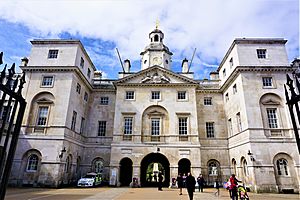
The Household Cavalry Museum is the official museum of the Household Cavalry. It is located inside the Horse Guards building. Visitors can watch the horses in their stables through a glass wall. These stables are from the 1700s.
The museum has exhibits that explain the training and history of the regiment. You can see ceremonial uniforms, royal flags, awards, musical instruments, horse gear, and silver items by Fabergé.
Visitors can also watch the afternoon inspection of the guards and horses. This happens every day at 4 pm. This tradition started in 1894. Queen Victoria found the guards not doing their duty. She ordered that they would have a 4 pm inspection every day for the next 100 years. This order officially ended in 1994. However, Queen Elizabeth II chose to continue the inspection to respect the tradition.
Ceremonial Duties
Every morning, the mounted King's Life Guard rides from Hyde Park Barracks. They ride through Hyde Park Corner, Constitution Hill, and The Mall. They arrive at Horse Guards to take over guard duties. This ceremony happens at 11:00 am, or 10:00 am on Sundays.
The guard is usually provided by the Household Cavalry Mounted Regiment. This regiment has soldiers from two Household Cavalry groups. These are the Life Guards, who wear red jackets and white helmet plumes. The other group is the Blues and Royals, who wear blue jackets and red plumes. Sometimes, other mounted units from Britain or other Commonwealth realms also take part. Examples include the King's Troop, Royal Horse Artillery and the Royal Canadian Mounted Police.
When the King or Queen is in London, the Guard is bigger. It includes one officer and twelve other soldiers. This is called a Long Guard. When the King or Queen is not in London, the Guard is smaller. It has two non-commissioned officers and ten troopers. This is known as a Short Guard.
The ceremony of Changing The King's Life Guard takes place on Horse Guards Parade. This is right next to the Horse Guards building. Two mounted guards stand at the entrance to Horse Guards on Whitehall. They are there from 10:00 am until 4:00 pm and change every hour. There is also a parade of dismounted (not on horseback) guards at 4:00 pm. Two dismounted guards stay on duty until 8:00 pm.
Gallery





